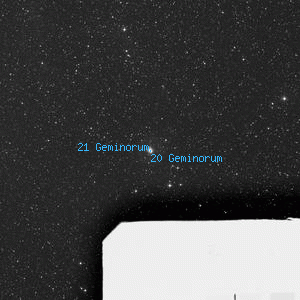20 Geminorum

Overlaid DSS image of 20 Geminorum, 60' x 60' with north at top and west to the right
Aladin viewer for the region around 20 Geminorum
20 Gem
Σ 924A, BD+17 1286, HD 46136, WDS J06323+1747A, SAO 95795, GSC 01333-01679, HIP 31158, Gaia DR3 3371047988717092096
Σ 924A, BD+17 1286, HD 46136, WDS J06323+1747A, SAO 95795, GSC 01333-01679, HIP 31158, Gaia DR3 3371047988717092096
| Type | Star |
|---|---|
| Magnitude | 6.242 | Right Ascension | 6h 32' 18.6" (2000) |
| Declination | 17° 47' 4" N |
| Constellation | Gemini |
| Classification | F7III |
Observing Notes
Andrew Cooper
Nov 23, 2023 Waikoloa, HI (map)
20cm f/6 Newtonian, Cave Astrola @ 76x
Seeing: 6 Transparency: 6 Moon: 0%
20 Gem and 21 Gem are a fine pair of 6th magnitude stars separated by 20", 21 Gem is the northeastern component, a pale yellow contrasting nicely with the white 20 Gem to the southwest, both are set in a field rich with stars close to the galactic plane
Gaia EDR3 data shows 20 Gem and 21 Gem share closely matching parallax and proper motion
Captain William Henry Smyth
Dec 28, 1833 No. 6 The Crescent, Bedford, England (map)
150mm f/17.6 refractor by Tully 1827
A neat double star, on Castor's left heel, about 1½° to the north-north-west of the bright star γ Geminorum; where a line carried from Rigel over the middle component of Orion's belt, will point it out at about 14° beyond Betelgeuze. A 8, topaz yellow; B 8½, cerulean blue.
A little explanation may be requisite on the identity of the individuals constituting this pair, for Piazzi asserts that Bradley, with but one exception, always observed 21 Geminorum for 20. Mr. Baily says that 21 does not exist, at least in the position given by the British Catalogue, observing: "The observation, from which it has been deduced by Flamsteed, was made on February 19, 1696, at 7 h 26 m 50 s; as may be seen MSS. vol. xxiii. page 43. Most of the modern astronomers have supposed it to be Piazzi vi. 135; or the second of the two stars forming the double star 20 Geminorum. But this is on the assumption that Flamsteed has made an error of l m in recording the time; and that 7h 26m 50s ought to be read 7h 25m 50s . Although this is very probable, (a similar mistake having certainly been twice committed on the same day with two previous stars,) yet there is nothing in the original MS. entry to warrant the conclusion. It is the only solution, however, of the difficulty."
[Wagman in Flamsteed's Missing Stars 1987 lists 21 Gem as non-existent with the following note: Peters in "Flamsteed's Stars", p. 75, believes it to be the same as 20 Gem.]
This is a very fine object, and was classed 46 ♅ IV., in 1781, but no measures of position were given, and only an estimated distance of 25". H. and S., therefore, afford the earliest micrometrical point of departure; and their measures, compared with those of Σ. and my own, show that no appreciable change has occurred in twelve years:H. and S. Pos. 208° 57 Dist. 19".454 Ep. 1822.05
Σ. 209° 48' 20".012 1830.00
[WDS 211° 19".90 2019 ]― A Cycle of Celestial Objects Vol II, The Bedford Catalogue, William Henry Smyth, 1844
Other Data Sources for 20 Geminorum
Associated objects for 20 Geminorum
Nearby objects for 20 Geminorum
12 objects found within 120'
| 19 Geminorum | 21 Geminorum | 22 Geminorum |
| 23 Geminorum | AB Geminorum | Alhena |
| Bochum1 | CR Geminorum | Jonckheere 900 |
| NGC 2218 | NGC 2234 | PK194+2.1 |
Credits...
Drawings, descriptions, and CCD photos are copyright Andrew Cooper unless otherwise noted, no usage without permission.
A complete list of credits and sources can be found on the about page
20 Geminorum